How to Play Yu-Gi-Oh!: The Absolute Basics
Welcome to the first part of our discussion and introduction to the world of Yu-Gi-Oh! In these articles, we’ll be trying to explain the rules of the game in a logical and easy to follow fashion, explaining potential points of confusion along the way.
What is Yu-Gi-Oh?
Yu-Gi-Oh is potentially the most complex widely available card game at the moment, and can be incredibly involved and ‘combo’ based. Most victories in Yu-Gi-Oh are completed by reducing the opponent’s life points to 0, although there are several alternate ways of winning, with ‘milling’ (reducing the opponent’s deck to zero cards) and gathering five specific cards (Exodia) being the most notable. Players will find that the game is incredibly fast-paced compared to other card games, as unlike Magic the Gathering or Cardfight! Vanguard, all cards can be used from turn one. There is no waiting to gather enough land, nor are units limited based on the Grade of a single unit, so players are potentially able to summon huge monsters right from the start of the game! This is countered by the fact that Yu-Gi-Oh has many powerful cards which can be used on your opponent’s turn to disrupt their plays, making the game very interactive. Your opponent might be able to summon their most powerful monsters, but you can simply destroy them all with a single Trap card! Yu-Gi-Oh, therefore, plays very differently to other card games on the market, and offers an interesting challenge for both players.
Cards
There are three primary types of cards in Yu-Gi-Oh, all of which have very different purposes: monsters, spells and traps. All of these have various sub-types, but the general principle is that traps are able to be used on your opponent’s turn, spell cards on your own and monsters on both. Therefore, let’s have a look at some examples:
Monster Cards
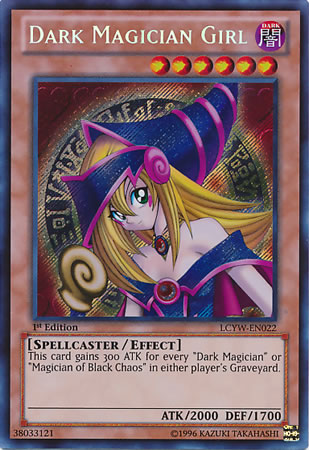 This is an example monster card: Dark Magician Girl. In the top right hand corner is her Attribute (Dark), and beneath that there is her Level (6), represented by stars. The centre of the card is taken up by her portrait, while a smaller box underneath contains her other details. The text in brackets ([Spellcaster/Effect] shows her Type (Spellcaster) and the fact that she has an ability, described in the box below. In the bottom right of the box, we can see her combat statistics: 2000 attack, and 1700 defence. The other parts of the card are not used in gameplay, being a set number, serial number (used for inputting the card in the video games) and a hologram to prove the card’s authenticity.
This is an example monster card: Dark Magician Girl. In the top right hand corner is her Attribute (Dark), and beneath that there is her Level (6), represented by stars. The centre of the card is taken up by her portrait, while a smaller box underneath contains her other details. The text in brackets ([Spellcaster/Effect] shows her Type (Spellcaster) and the fact that she has an ability, described in the box below. In the bottom right of the box, we can see her combat statistics: 2000 attack, and 1700 defence. The other parts of the card are not used in gameplay, being a set number, serial number (used for inputting the card in the video games) and a hologram to prove the card’s authenticity.
Monsters can have one of seven Attributes (Light, Dark, Fire, Water, Wind, Earth and Divine), and one of many types (too many to list!). A monster’s level can be anywhere between 0 and 12, with most cards being four or below. Cards can have multiple types listed – it is possible to see a card have [Spellcaster/Pendulum/Effect], or even more combinations! The relevance of these specific types will be discussed later. Monsters serve as the primary form of offence and defence in the game.
Spell (Magic) Cards
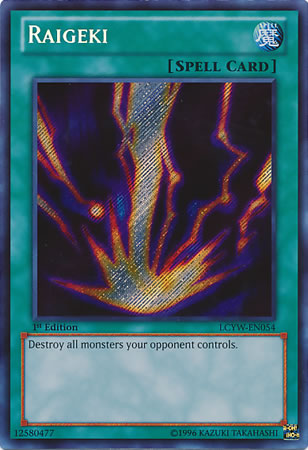 Spell cards (known as Magic cards in the oldest sets) are usually only able to be used on your own turn. Their rough layout is similar to monster cards. The symbol for Spell takes the place of the Attribute, and [Spell Card] takes the place of the monster’s level. The art occupies the centre of the card, while the box below describes its effect. Spell cards also have various subtypes, shown by a symbol next to the phrase [Spell Card]. These can be Continuous, Equip, Field, Ritual or Quick Play, but usually have no sub-type at all. Most Spell cards, with the exception of Quick Plays, can only be used on the user’s own turn during the main phase. Further, Spell cards usually are used to provide a single, powerful effect, although Continuous, Equip and Field spells stay on the field until they are destroyed, and provide lasting abilities.
Spell cards (known as Magic cards in the oldest sets) are usually only able to be used on your own turn. Their rough layout is similar to monster cards. The symbol for Spell takes the place of the Attribute, and [Spell Card] takes the place of the monster’s level. The art occupies the centre of the card, while the box below describes its effect. Spell cards also have various subtypes, shown by a symbol next to the phrase [Spell Card]. These can be Continuous, Equip, Field, Ritual or Quick Play, but usually have no sub-type at all. Most Spell cards, with the exception of Quick Plays, can only be used on the user’s own turn during the main phase. Further, Spell cards usually are used to provide a single, powerful effect, although Continuous, Equip and Field spells stay on the field until they are destroyed, and provide lasting abilities.
Trap Cards
Trap cards are the primary form of card which can be used on your opponent’s turn, but cannot be used on your own turn without waiting. They are placed face-down on the field and must have been on the field for a whole turn before they can be used! However, after that, they may be used at any appropriate time for their effect. As a result, Trap cards are slower than Spell cards to use their effects, but are much more flexible in their activation after they have been prepared. Trap cards, like Spell cards, have several sub-types, shown by a symbol next to the phrase [Trap Card]. These are Continuous and Counter traps. Continuous traps, as the name suggests, stay on the field after their activation. Counter traps, on the other hand, usually prevent the effects of other cards and can only be responded to with another Counter trap! As such, Counter traps are often considered to be the strongest type of effect in the game, as it is very difficult to stop their effects from activating.
The Field
The field for Yu-Gi-Oh is sizable, and has many different zones. There are five spaces for monsters, each of which can contain one monster. Similarly, there is a row of five spaces for spell and trap cards, where cards may be placed face down or face up to be used. Field Spell cards are never placed in this back-row, occupying their own ‘Field Spell Zone’ instead. Each of these spaces may only be occupied by a single card, which will prevent the player from being able to use any more of that type of card when they are full. Two Pendulum zones, used for a special kind of summoning, are placed on either side of the field – their use will be explained later. The Extra deck contains powerful monsters which can be summoned at will, provided certain conditions are met. The Graveyard (or Grave) is where used and destroyed monsters, spells and traps go.
Setting-Up
Yu-Gi-Oh has a simple set up. Players simply shuffle their decks and draw a hand of five cards. Then, the players also set aside their Extra Deck of up to fifteen cards. Players set their life-points at 8000 to begin the game. The player going first opens their turn without drawing, as going first is a significant advantage in Yu-Gi-Oh. After that, play proceeds as normal.
Turn Structure
The order of a turn is as follows:
- Draw Phase
- Standby Phase
- Main Phase (1)
- Battle Phase
- Main Phase (2)
- End Phase
Draw Phase
In this phase, the turn player draws a card, unless another effect has prevented them from doing so. The player who goes first skips their first draw phase.
Standby Phase
The Standby phase is usually the part of the turn where the costs for continuous effects are paid. This can be considered similar to ‘upkeep’ in other games. Cards will specify that their costs or effects are to be used in this phase.
Main Phases
Yu-Gi-Oh has two main phases, one on either side of the battle phase. This phase is where the majority of actions occur in a turn, including summoning monsters, playing Spell cards and setting Trap cards. During this phase, players can change the battle positions of their monsters from face-down defence position to face-up attack position, or from face-up attack position to face-up defence position. Cards cannot be turned face down unless an effect allows them to do so! Players may use as many Spell or Trap cards as they wish during their turn, provided that they have enough space to play them.
Battle Phase
During the battle phase, you can declare attacks with your monsters. Only monsters in Attack Mode can attack, and they need to attack monsters on your opponent’s side of the field before they can attack your opponent. Monsters do not have to attack, and the player chooses when to end their battle phase and enter main phase 2. Monsters summoned in main phase 2 will not be able to attack, as there is only one battle phase per turn!
End Phase
The end phase is essentially a ‘clean-up’ step. Cards whose effects activate or end at the end of the turn happen at this time. Once this step has finished, the opponent’s draw phase begins.
Summoning Monsters
There are two main types of summoning in Yu-Gi-Oh! and three ‘battle positions’ which monsters can take. These are face-up Attack position, face-up Defence position and face-down Defence position.
Normal Summoning and Normal Setting
Normal summoning is the default manner in which monsters are summoned in Yu-Gi-Oh!. Players are allowed to Normal Summon or Set once each turn during either Main Phase, although some effects can allow players to Normal Summon more than once per turn. Normal Summoning can summon monsters in either face-up Attack position, or face-down Defence position, which are represented by placing the card vertically or horizontally respectively.
This is an example of a monster in face-up attack position, the result of a normal summon.
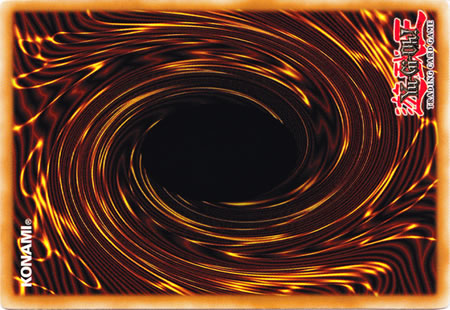
This is an example of a monster in face-down defence position, the result of a normal set.
We shall get onto the relevance of these positions when we cover combat, but for now, we shall learn how to normal summon and set!
All normal summons and sets are performed by taking a card from the hand and placing it on an empty monster card zone in either of these two positions. Monsters cannot be normal summoned in face-up defence position, and monsters placed in face-down defence position are completely unknown to your opponent! There are, however, some restrictions on normal summoning monsters, which are based on the card’s level. Monsters with a level of 4 or less can be normal summoned or set for free. Monsters with a level of 5 or 6 require one tribute, and monsters with a level of 7 or higher require two. This is known as a Tribute Summon or a Tribute Set, and still counts as your single normal summon a turn. But what is a tribute? Simply put, to summon these monsters, you have to send a monster (which is the ‘tribute’) from the field to the graveyard. Therefore, to Tribute Summon high level monsters, you need to already have some monsters on the field to sacrifice! If you decide to summon a level 5 or higher monster in face-down defence position, then you still need to offer a monster as a tribute. Your opponent, however, knows only that the card’s level is greater than 5, as all other attributes stay hidden.
Special Summoning
Special Summoning can be performed as many times as a player wishes per turn, but can only be performed through the effects of cards. Special Summoning has no restrictions based on level, and, depending on the effect, monsters can be summoned in face-up attack mode, face-up defence mode or face-down defence mode (which is the rarest position for Special Summoning effects, and effects that allow it will specifically say that you can summon in this position). These often occur during the main phase, although Special Summons can occur during any phase of the turn.
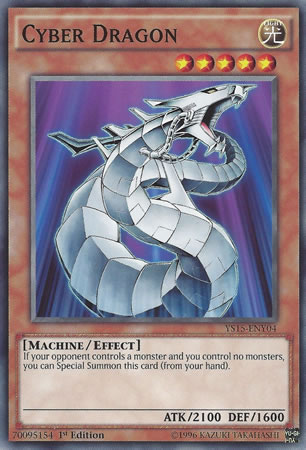
This is an example of a monster which can Special Summon itself. This is free to do (as the card does not state it has a cost), and can be done provided the conditions are met. If you go second, you can summon this, and then Normal Summon another monster, allowing you to gain a significant advantage over your opponent. The summoned Cyber Dragon can even be used for a tribute for a Tribute Summon or Set! Cyber Dragon can be Special Summoned in either face-up attack or face-up defence mode.

Monsters are not the only effects which can allow Special Summoning. Monster Reborn is a straightforward (but banned) card which can Special Summon destroyed monsters. When this Spell card is used, it summons a monster in either face-up attack or defence position.
There are also other specialised forms of Special Summoning, which are Ritual Summoning, Fusion Summoning, Synchro Summoning, XYZ Summoning and Pendulum Summoning, which we will cover in a later article.
(Flip Summoning)
Flip Summoning is technically a type of summon, but is more akin to simply changing a battle position! When you decide to turn your face-down defence monster to attack position, it is turned face-up. This does not count as your Normal Summon for the turn, and is included here for the sake of completeness.
Combat
Combat in Yu-Gi-Oh all takes place in a single battle phase and can only be initiated by monsters in attack position. These monsters declare their attacks one by one and in turn, and do not have to attack at all if their controller does not want them to. Monsters can attack the opponent to reduce their life points, but only if the opponent controls no monsters. Therefore, you have to attack and destroy your opponent’s monsters before you can begin doing significant damage to your opponent!
When monsters battle, there are different results depending on their battle positions and attack power. As a rule, whoever has the higher power wins, although how the victory manifests can change substantially!
Attacking Monster vs Opponent’s Attack Position Monster
When your attacking monster battles an opponent’s monster in attack position, the monster which has the lower ATK power is destroyed and sent to the graveyard. Further, the controller of that monster takes damage from their life points equal to the difference in power! In this example, the turn player’s Blue-Eyes White Dragon attacks the opponent’s Dark Magician. Blue-Eyes’ attack is 3000, while Dark Magician’s is only 2500. As such, Dark Magician is destroyed and its controller takes 500 damage to their life points. If you attack a monster with a higher attack, your monster will be destroyed and you will lose life points equal to the difference – so it’s worth being careful of traps which can increase the opponent’s attack points!
In this example, Dark Magician attacks an opponent with the same amount of attack points. In this situation, both monsters are destroyed and neither player takes any damage.
Attacking Monster vs Opponent’s Defence Position Monster
You can declare attacks on either face-up or face-down position monsters, but the risk with the latter is that you do not know their statistics! When you declare an attack against a face-down monster, you only flip it into face-up defence position after your attack has begun, so you cannot back out if it turns out that you will lose the battle. The defending monster uses its defence power to see who wins.
In this example, Dark Magician attacks the face-down card, and does not know what the monster’s defence is. Dark Magician’s owner is confident that its 2500 attack is enough to defeat any level four or lower monster, and so attempts the battle.
However, the face-down defence position monster turns out to have 2600 defence, which is enough to survive the attack. Big Shield Gardna therefore survives the battle, and Dark Magician’s controller takes the difference in damage to their life points. However, Dark Magician is not destroyed, as there is no penalty for losing a battle against a defence position monster.
In this example, Dark Magician’s attack is higher than Summoned Skull’s 1200 defence, and so Summoned Skull is destroyed. The controller of the Summoned Skull takes no damage, as players do not take damage for their defence position monsters losing in battle. This means that it is often wise to place monsters into defence position when facing monsters with powerful attacks, as this allows you to avoid losing life points!
In the case of a tie between the attacking monster’s attack and the defending monster’s defence, neither monster is destroyed and neither player takes any damage.
Conclusion
In this instalment, we have learned the types of card, the structure of a turn, how to summon and how to battle. In the next instalment, we’ll focus more on Spells, Traps and Effect monsters!
Yu-Gi-Oh! singles are available to purchase at Big Orbit Cards: Yu-Gi-Oh!

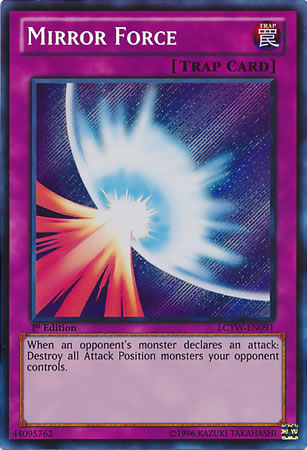
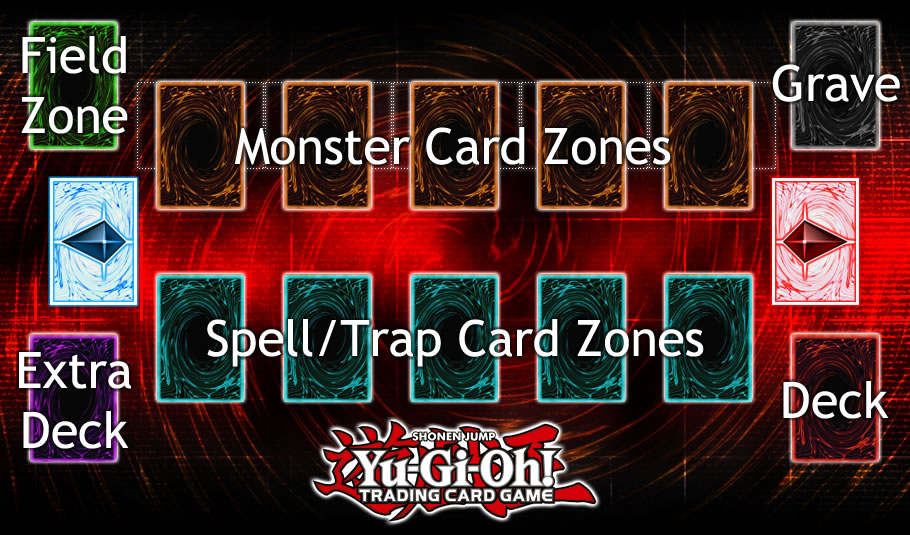
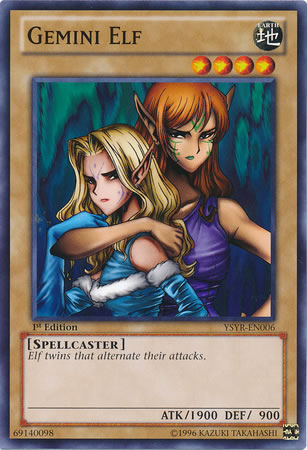
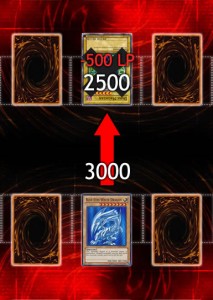
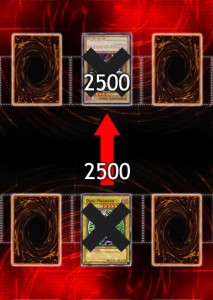
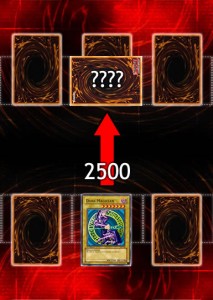
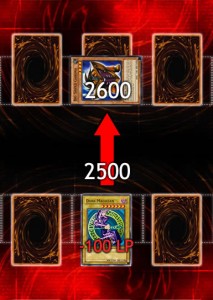
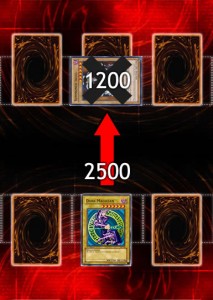
Pingback:How to Play Yu-Gi-Oh!: Spells, Traps and Effects in Depth | Big Orbit Games